Blue Iguana
- March 6, 2024
- 0 comment
The Blue Iguana, scientifically known as Cyclura lewisi, is a fascinating reptile native to the lush forests and rocky terrain of the Grand Cayman Islands in the Caribbean. Renowned for its vibrant blue coloration, this enigmatic creature stands out amidst its surroundings, captivating the attention of observers and researchers alike. Blue iguanas play a crucial role in their ecosystem, acting as seed dispersers and contributing to the regeneration of vegetation in their habitat.
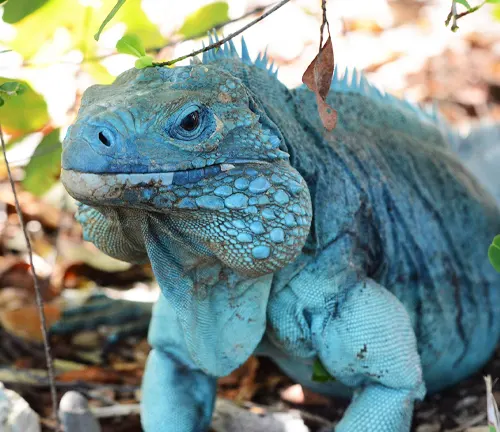
However, these majestic creatures face numerous threats, including habitat loss, invasive species predation, and illegal poaching. Conservation efforts, such as captive breeding programs and habitat restoration initiatives, are underway to safeguard the future of this endangered species. Despite the challenges they encounter, blue iguanas continue to inspire awe and admiration, serving as a symbol of resilience and the importance of protecting our planet’s diverse wildlife.
| Aspect | Description |
|---|---|
| Scientific Name | Cyclura lewisi |
| Common Name | Blue Iguana |
| Habitat | Grand Cayman Islands, Caribbean |
| Coloration | Vibrant blue with shades of gray and green |
| Size | Up to 5 feet in length |
| Weight | Between 15 to 25 pounds |
| Diet | Primarily herbivorous, feeding on vegetation |
| Lifespan | Approximately 15 to 20 years in the wild |
| Conservation Status | Endangered (IUCN Red List) |
| Threats | Habitat loss, invasive species, illegal poaching |
| Conservation Efforts | Captive breeding programs, habitat restoration projects |
| Ecological Role | Seed disperser, ecosystem maintainer |
Habitat and Distribution
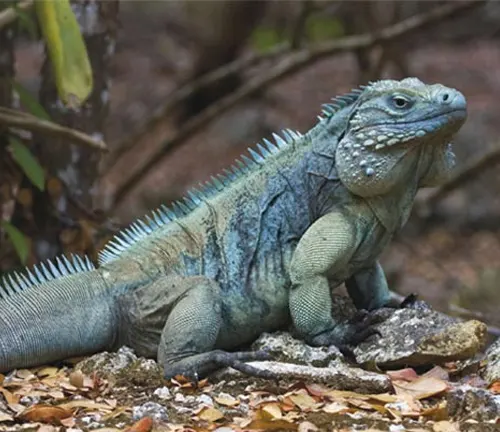
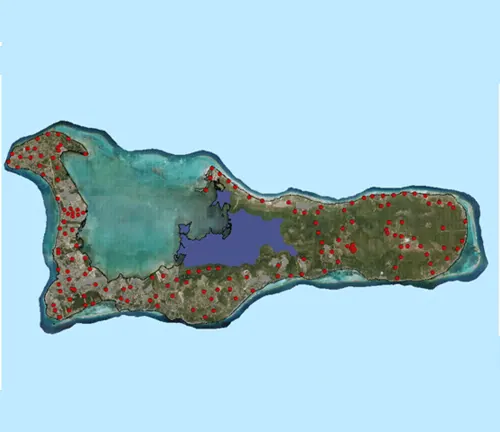
The Blue Iguana, scientifically known as Cyclura lewisi, is primarily found in the lush forests and rocky terrain of the Grand Cayman Islands in the Caribbean. Within the Grand Cayman Islands, these iguanas inhabit a range of habitats, including dry forests, scrublands, and rocky outcrops. They are particularly prevalent in areas with dense vegetation and access to fresh water sources. While the Grand Cayman Islands serve as the primary stronghold for blue iguanas, they can also be found on smaller nearby islands, although in smaller populations. Despite their limited distribution, blue iguanas play a crucial role in their ecosystems, contributing to seed dispersal and vegetation regeneration. Efforts to conserve and restore their habitat are essential for ensuring the survival of this endangered species.
Grand Cayman Islands: A Blue Iguana Haven
The Grand Cayman Islands serve as a haven for the Blue Iguana, providing ideal habitats for their survival and reproduction. Within the Grand Cayman Islands, blue iguanas can be found in various ecosystems, including dry forests, scrublands, and rocky areas. These reptiles thrive in the island’s warm climate and diverse vegetation, which offer ample food sources and shelter. Protected areas and conservation reserves on the Grand Cayman Islands play a crucial role in safeguarding blue iguana populations and their habitats.
Sister Islands: Secondary Habitats
While the Grand Cayman Islands remain the primary habitat for blue iguanas, they can also be found on smaller nearby islands, known as the Sister Islands. Although these islands have less extensive habitats compared to the Grand Cayman Islands, they still provide secondary habitats for blue iguanas. The habitats on the Sister Islands may differ in terms of vegetation composition and availability of resources, but they still support populations of blue iguanas. Conservation efforts extend to these secondary habitats to ensure the long-term survival of blue iguanas across their range.
Physical Characteristics
Describe the unique physical traits and features of blue iguanas that distinguish them from other iguana species.
Morphological Adaptations
The Blue Iguana boasts a range of morphological adaptations that contribute to its survival in its native habitat. These adaptations have evolved over time to suit the iguana’s ecological niche and lifestyle.
One notable morphological adaptation is the iguana’s sturdy build and muscular physique. Blue iguanas have robust bodies with strong limbs and powerful jaws, enabling them to forage for food, climb trees, and defend themselves against predators effectively. This muscularity also aids in their ability to dig burrows for shelter and nesting.
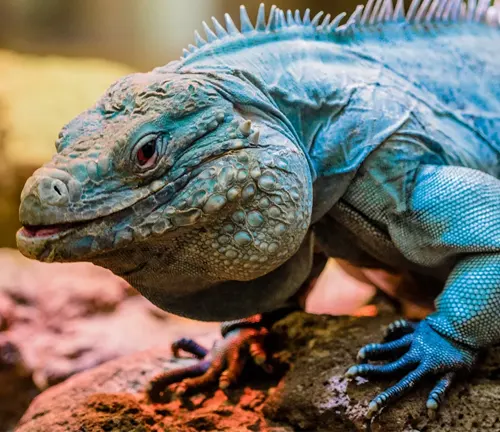

Coloration and Camouflage
The striking blue coloration of the Blue Iguana serves multiple purposes, including camouflage and thermoregulation. In their natural habitat of the Grand Cayman Islands, blue iguanas blend seamlessly with their surroundings, especially in the dense vegetation and rocky terrain where they reside. This camouflage helps them avoid detection by predators, such as birds of prey and terrestrial predators like feral cats.
Behavior and Lifestyle
Explore the typical behavior patterns and daily life of blue iguanas in the wild.
Basking Behavior
Basking behavior is a crucial aspect of the Blue Iguana’s daily routine and plays a vital role in maintaining its physiological well-being. As ectothermic reptiles, blue iguanas rely on external sources of heat to regulate their body temperature and metabolism. Basking allows them to absorb solar radiation, which helps elevate their body temperature and stimulate metabolic processes.
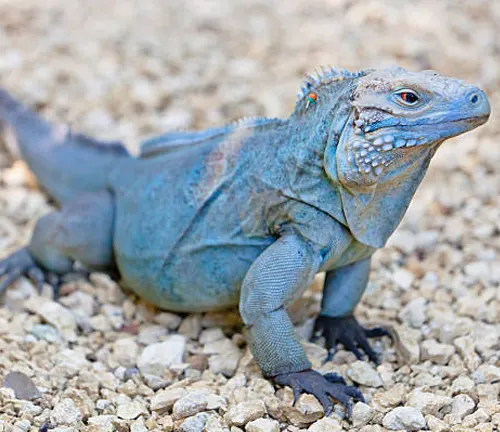
In their natural habitat of the Grand Cayman Islands, blue iguanas can often be observed basking on rocks, fallen logs, or branches, soaking up the warmth of the sun’s rays. They may also assume specific postures, such as spreading out their limbs or flattening their bodies against a surface, to maximize their exposure to sunlight.
Social Interactions
Blue iguanas exhibit a range of social behaviors and interactions within their populations, which contribute to their social structure and reproductive success. While they are primarily solitary animals, blue iguanas may congregate in communal basking sites or feeding areas, especially during the breeding season or favorable weather conditions.
During these gatherings, individuals may engage in various social behaviors, including territorial displays, courtship rituals, and dominance hierarchies. Adult males, in particular, may engage in head-bobbing displays and dewlap extensions to assert dominance and attract potential mates.
Social interactions among blue iguanas also extend to communication through visual and olfactory cues. They may use body language, such as head movements and tail flicks, to convey information about their intentions or establish social hierarchies. Additionally, scent marking and chemical signaling play a role in identifying individuals and marking territories.
Diet and Feeding Habits
Herbivorous animals, those that primarily consume plant-based foods, exhibit a fascinating behavior known as selective feeding. This behavior involves the deliberate choice of certain plant species or parts while avoiding others, based on various factors such as nutritional content, palatability, and ecological considerations.
Herbivorous Diet

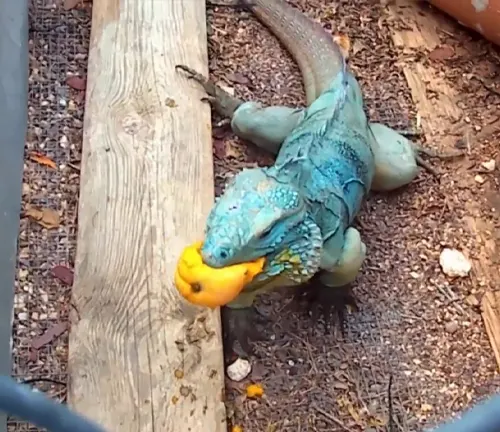
A herbivorous diet is characterized by the consumption of plant material as the primary source of nutrition. Herbivores have evolved specialized digestive systems adapted to break down cellulose and extract nutrients from plant cell walls. This dietary preference is observed across a wide range of animal species, including mammals, birds, insects, and reptiles.
Selective Feeding Behavior
Selective feeding behavior refers to the ability of herbivores to discriminate between different plant species or parts and actively choose those that best meet their nutritional needs. This behavior is influenced by a combination of intrinsic factors, such as taste preferences and physiological requirements, as well as extrinsic factors, including the availability and quality of food resources.
Factors Influencing Selective Feeding Behavior:
Several factors influence selective feeding behavior in herbivores:
- Nutritional Content: Herbivores may preferentially select plants with higher protein, carbohydrate, or lipid content to meet their dietary requirements.
- Secondary Compounds: Plants produce secondary compounds, such as tannins and alkaloids, as defense mechanisms against herbivory. Herbivores may avoid plants with high concentrations of these compounds due to their bitter taste or toxic effects.
- Physical Characteristics: The texture, color, and smell of plants can influence an herbivore’s food preferences. For example, they may select tender leaves over tough stems or brightly colored fruits indicating ripeness.
- Seasonal Availability: Changes in plant phenology, such as flowering and fruiting seasons, can affect the availability and quality of food resources for herbivores, leading to shifts in feeding preferences.
- Social Learning: Some herbivores learn food preferences from conspecifics or through trial and error, adapting their feeding behavior based on the experiences of others.
Benefits of Selective Feeding Behavior:
Selective feeding behavior offers several advantages to herbivores:
- Nutritional Optimization: By selecting plants with higher nutrient content, herbivores can meet their dietary requirements more efficiently and maintain optimal health and fitness.
- Toxin Avoidance: Avoiding plants with high concentrations of secondary compounds reduces the risk of toxicity and digestive disturbances in herbivores, enhancing their survival and well-being.
- Energy Conservation: Selective feeding allows herbivores to conserve energy by focusing their foraging efforts on high-quality food resources, minimizing unnecessary consumption of low-nutrient or toxic plants.
- Minimized Competition: By specializing in specific plant species or niches, herbivores can reduce competition with other species for food resources, thereby maximizing their access to preferred food items.
- Reduced Predation Risk: Avoiding toxic plants and selecting nutritious alternatives can decrease herbivores’ susceptibility to predation, as they remain healthy and alert in their environment.
Reproduction and Life Cycle
Mating Rituals
Mating rituals are elaborate behaviors and displays performed by animals during the breeding season to attract mates and ensure successful reproduction. These rituals vary widely among species and may involve intricate courtship displays, vocalizations, or physical interactions.
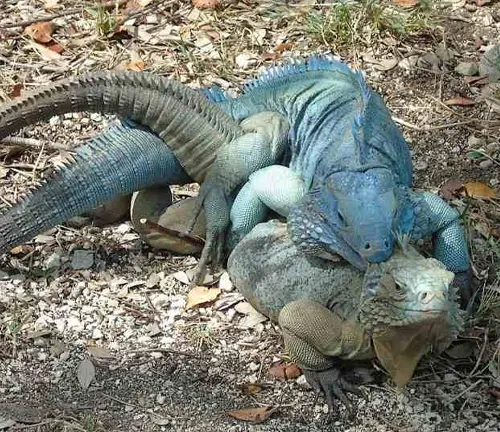
In many species, males compete for the attention of females through displays of strength, dominance, or vitality. These displays can include flamboyant plumage, elaborate dances, or aggressive confrontations with rivals. Females may choose mates based on the quality of these displays, selecting individuals with desirable traits such as vigor, health, or genetic compatibility.
Nesting and Incubation
After mating, many species engage in nesting behavior to provide a safe and suitable environment for egg-laying and incubation. Nesting strategies vary widely among different taxa and may involve constructing elaborate structures, excavating burrows, or selecting pre-existing sites such as tree hollows or rock crevices.
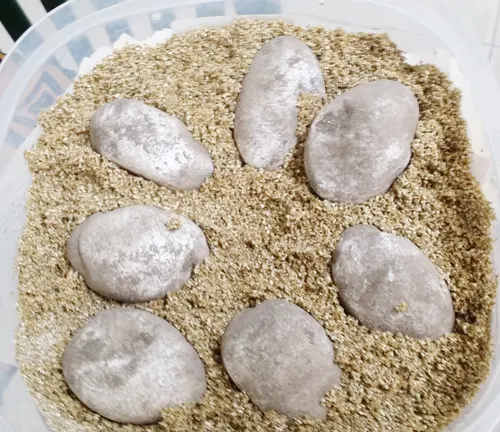
During incubation, one or both parents may take turns sitting on the eggs to keep them warm and protect them from predators. Incubation periods can vary from a few days to several weeks, depending on the species and environmental conditions.
Once the eggs hatch, parents continue to care for the offspring, providing food, protection, and guidance as they grow and develop. In some species, parental care extends beyond the hatching stage, with parents feeding and nurturing their young until they are capable of surviving on their own.
Conservation Status
Assess the current conservation status of blue iguanas and the factors contributing to their endangered status.
IUCN Red List Classification
The IUCN Red List of Threatened Species is a comprehensive database that assesses the conservation status of various plant and animal species worldwide. Species are categorized into different classifications based on their risk of extinction, ranging from “Least Concern” to “Extinct.” These classifications help prioritize conservation efforts and inform policy decisions aimed at protecting biodiversity.
The categories used in the IUCN Red List classification system include:
- Least Concern (LC): Species in this category are abundant and widespread, with no immediate threat of extinction.
- Near Threatened (NT): Species that are close to meeting the criteria for being classified as “Vulnerable” but are not yet considered at high risk of extinction.
- Vulnerable (VU): Species that are facing a high risk of extinction in the wild due to factors such as habitat loss, overexploitation, or climate change.
- Endangered (EN): Species that are at a very high risk of extinction in the wild, with populations declining rapidly and facing significant threats to their survival.
- Critically Endangered (CR): Species that are at an extremely high risk of extinction in the wild, with populations severely fragmented or declining rapidly.
- Extinct in the Wild (EW): Species that survive only in captivity or as cultivated populations, with no remaining individuals in their natural habitat.
- Extinct (EX): Species that have completely disappeared from the wild and no longer exist anywhere on Earth.
The IUCN Red List classification provides valuable information about the conservation status of species and helps guide conservation efforts aimed at preventing extinctions and restoring populations to sustainable levels.
Population Trends
Population trends refer to changes in the abundance and distribution of a species over time. Monitoring population trends is essential for assessing the health of ecosystems and identifying potential threats to biodiversity.
Population trends can be influenced by various factors, including habitat loss, pollution, climate change, overexploitation, and invasive species. Positive population trends indicate increasing numbers or expanding ranges, while negative trends suggest declining populations or shrinking habitats.
Monitoring population trends involves collecting data through field surveys, satellite imagery, remote sensing, and citizen science initiatives. By analyzing population data over time, researchers can identify patterns, assess the effectiveness of conservation measures, and develop strategies to mitigate threats to species’ survival.
Threats to Blue Iguanas
Identify the primary threats facing blue iguanas in the wild and the impact of human activities on their survival.
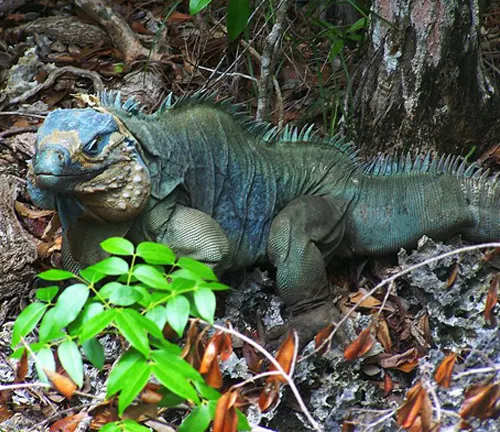
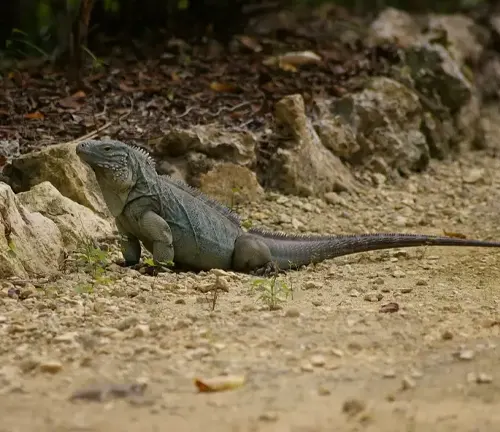
Habitat Loss and Fragmentation
Habitat loss and fragmentation are significant threats to the survival of blue iguanas and other wildlife species. As human populations expand and development encroaches on natural habitats, large tracts of land are cleared for agriculture, urbanization, and infrastructure projects. This loss of habitat reduces the availability of suitable nesting sites, food resources, and shelter for blue iguanas, forcing them into smaller, isolated areas.
Invasive Species Predation
Invasive species predation poses a significant threat to blue iguanas and their native ecosystems. Invasive predators, such as feral cats, rats, and dogs introduced to the Grand Cayman Islands by humans, prey on blue iguana eggs, juveniles, and adults, leading to population declines and decreased reproductive success.
Conservation Efforts
Highlight ongoing conservation efforts and initiatives aimed at protecting and restoring blue iguana populations.
Captive Breeding Programs
Captive breeding programs play a vital role in the conservation of blue iguanas and other endangered species. These programs involve breeding and rearing blue iguanas in controlled environments, such as zoos, wildlife sanctuaries, and dedicated breeding facilities, with the goal of increasing population numbers and genetic diversity.
Captive breeding programs serve several purposes:
- Population Recovery: Captive breeding programs help bolster blue iguana populations by producing offspring that can be reintroduced into the wild to supplement existing populations or establish new populations in suitable habitats.
- Genetic Diversity: By carefully managing breeding pairs and genetic lineages, captive breeding programs can help maintain genetic diversity within blue iguana populations, reducing the risk of inbreeding and genetic bottlenecks.
- Research and Education: Captive breeding programs provide valuable opportunities for research on blue iguana biology, behavior, and reproduction. They also serve as educational tools for raising awareness about the conservation status of blue iguanas and the importance of protecting their natural habitats.
- Insurance Population: Captive populations of blue iguanas serve as “insurance populations” against catastrophic events or unforeseen threats in the wild. They provide a reservoir of genetic diversity that can be used to supplement wild populations if necessary.
Habitat Restoration Projects
Habitat restoration projects are essential for reversing the impacts of habitat loss and fragmentation on blue iguana populations and restoring degraded ecosystems to their natural state. These projects involve restoring or creating habitat features, such as nesting sites, food resources, and shelter, to support blue iguana populations and enhance their survival and reproductive success.
Habitat restoration projects may include:
- Reforestation: Planting native vegetation in areas affected by deforestation or habitat degradation to restore habitat structure and function for blue iguanas and other wildlife species.
- Invasive Species Control: Removing invasive plant species and controlling invasive predators that threaten blue iguana populations and disrupt native ecosystems.
- Habitat Enhancement: Enhancing existing habitat features, such as rock outcrops, fallen logs, and vegetation patches, to provide suitable microhabitats for blue iguanas to bask, nest, and forage.
- Corridor Creation: Establishing habitat corridors or wildlife corridors to reconnect fragmented habitats and facilitate movement and dispersal of blue iguanas between isolated populations.
- Community Engagement: Involving local communities in habitat restoration projects through education, outreach, and participation in conservation activities to promote stewardship of natural resources and support for blue iguana conservation efforts.
Different Species
Cuban Blue Iguana
(Cyclura nubila)
Found in Cuba, this species is closely related to the Grand Cayman blue iguana and also exhibits blue-gray coloration. However, it is smaller in size compared to its Grand Cayman counterpart.

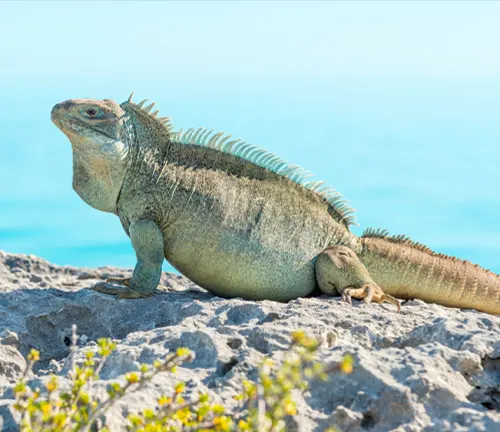
Turks and Caicos Rock Iguana
(Cyclura carinata)
Native to the Turks and Caicos Islands, this species is known for its robust build and variable coloration, which may include shades of blue along with other hues such as gray and green.
Utila Spiny-tailed Iguana
(Ctenosaura bakeri)
Found on the island of Utila in Honduras, this species is sometimes referred to as the “blue iguana” due to its blue-gray coloration and superficial resemblance to true iguanas. However, it belongs to a different genus (Ctenosaura) and is not closely related to Cyclura species.
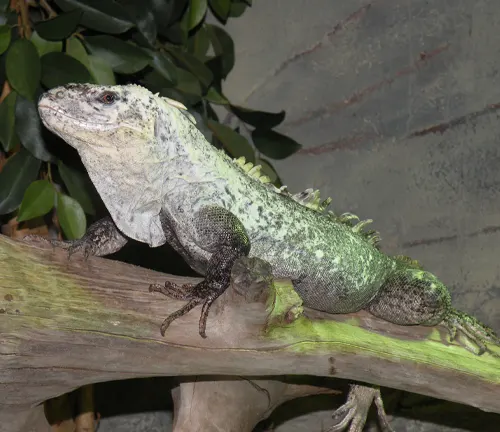
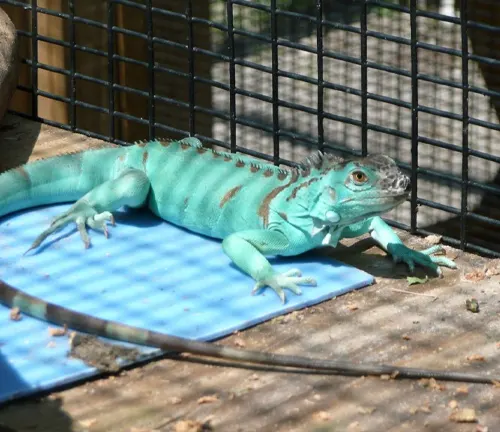
Blue Axanthic Iguana
In captivity, certain genetic mutations can result in iguanas with blue coloration. These blue axanthic iguanas are selectively bred for their unique appearance and are not a distinct species in the wild.
Frequently Asked Questions (FAQs)
- What is a blue iguana?
A blue iguana is a species of iguana native to the Grand Cayman Islands in the Caribbean. It is known for its striking blue-gray coloration and distinctive habitat preferences. - Are blue iguanas endangered?
Yes, blue iguanas are critically endangered. Habitat loss, predation by invasive species, and illegal hunting have contributed to their decline in the wild. - How big do blue iguanas get?
Blue iguanas are among the largest species of iguanas, with adults typically reaching lengths of up to 5 feet (1.5 meters) and weighing up to 30 pounds (14 kilograms). - What do blue iguanas eat?
Blue iguanas are primarily herbivorous, feeding on a diet of leaves, flowers, fruits, and other plant matter. They may also consume insects and small invertebrates opportunistically. - Where do blue iguanas live?
lue iguanas are endemic to the Grand Cayman Islands and are primarily found in dry forests, scrublands, and rocky coastal areas. - How long do blue iguanas live?
Blue iguanas have a relatively long lifespan, with individuals in captivity living up to 20 years or more. Lifespan in the wild may be shorter due to various threats and environmental factors. - What is being done to protect blue iguanas?
Conservation organizations and government agencies are implementing various measures to protect blue iguanas, including habitat restoration, captive breeding programs, and efforts to control invasive species. - Can blue iguanas be kept as pets?
Blue iguanas are not recommended as pets due to their specialized care requirements and endangered status. Keeping blue iguanas as pets may also contribute to the illegal wildlife trade and further endanger wild populations. - How can I help conserve blue iguanas?
Individuals can contribute to blue iguana conservation efforts by supporting reputable conservation organizations, avoiding purchasing or keeping blue iguanas as pets, and advocating for habitat protection and restoration. - Are blue iguanas aggressive?
Blue iguanas are generally shy and docile animals, but they may display territorial behavior or aggression if threatened or cornered. It’s important to respect their space and observe them from a distance in their natural habitat.


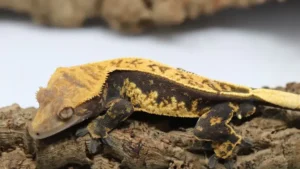
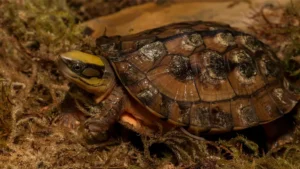
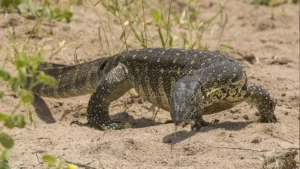
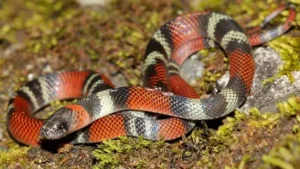
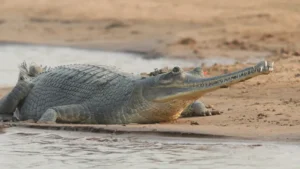
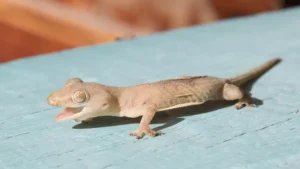

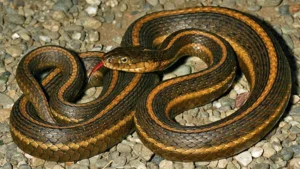

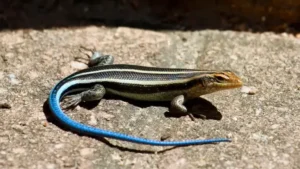

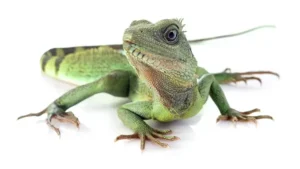
Leave your comment